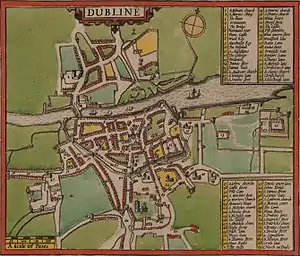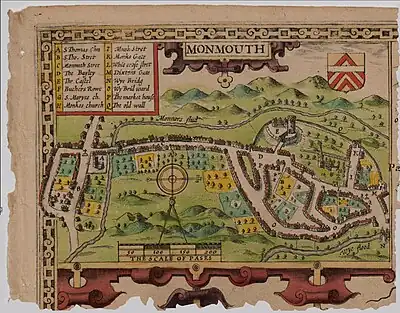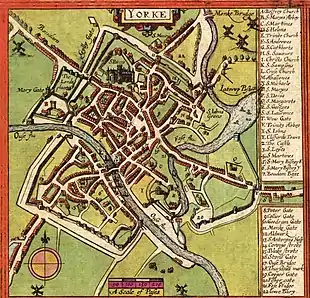John Speed
John Speed (1551 or 1552 – 28 July 1629) was an English cartographer, chronologer and historian of Cheshire origins.[1] The son of a citizen and Merchant Taylor in London,[2] he rose from his family occupation to accept the task of drawing together and revising the histories, topographies and maps of the Kingdoms of Great Britain as an exposition of the union of their monarchies in the person of King James I and VI.[3] He accomplished this with remarkable success, with the support and assistance of the leading antiquarian scholars of his generation. He drew upon and improved the shire maps of Christopher Saxton, John Norden and others, being the first to incorporate the hundred-boundaries into them, and he was the surveyor and originator of many of the town or city plans inset within them.[4] His work helped to define early modern concepts of British national identity. His Biblical genealogies were also formally associated with the first edition of the King James Bible. He is among the most famous of English mapmakers.[5][6]
John Speed | |
|---|---|
.jpg.webp) Memorial to John Speed, St Giles-without-Cripplegate | |
| Born | 1551 or 1552 Farndon, Cheshire |
| Died | 1629 (aged 76–77) St Giles-without-Cripplegate, Cripplegate, London |
| Scientific career | |
| Fields | Cartography, history |
Life
Origins and early life
According to his daughter Sarah Blackmore, John Speed was born in the Cheshire village of Farndon[7] in c. 1551/52.[8] Various families of Speed dwelt in that neighbourhood, but John's relation to them is not precisely established.[9][10] His father John Speed gained the freedom of the Company of Merchant Taylors of London in April 1556,[11] and is supposed to be the same John Speed who married Elizabeth Cheynye at Christchurch, Newgate Street in the City of London in January 1555/56.[12] From this it is inferred that Speed's birth-mother died during his infancy.

By his own account, Speed followed in his father's mercantile business in London,[13][1] and in 1580 he obtained the freedom of the Merchant Taylors' Company by patrimony.[14] He had married Susanna (born c. 1557/58),[8] daughter of Thomas Draper of London, in 1571 or 1572,[15] and began to raise a family.[16] Most sources state that they had twelve sons and six daughters, of whom the most famous to reach maturity was John Speed, M.D., who studied at Merchant Taylors' School, London and St John's College, Oxford.[2][17][18][19] It appears that the Speed family was fairly well-to-do.[20]
Patronage
Speed came to the attention of learned individuals,[21] among whom was Sir Fulke Greville: Greville, "perceiving how his wide soul was stuffed with too narrow an occupation" (as Thomas Fuller has it),[7] thereafter made him an allowance to enable him to devote his whole attention to research:[22]
[His] merits to me-ward I do acknowledge, in setting this hand free from the daily employments of a manual trade, and giving it his liberty thus to express the inclination of my mind, himself being the procurer of my present estate.[7][21]
In around 1590 Speed was working with the Puritan scholar Hugh Broughton, and developing their work on the genealogies of Jesus Christ. By 1595 he published a map of biblical Canaan,[23] and in 1598 he presented his maps to Queen Elizabeth. As a reward for these efforts, Elizabeth granted Speed the position of a Waiter (a customs officer):
Mr Fulke Greville has just brought me word of Her Majesty's pleasure that I should write you that there is a waiter's room of the Custom-house fallen in, which she has long determined might be bestowed upon John Speed, who has presented her with divers maps; she therefore desires you will bestow the place upon him, whom she takes to be a very sufficient man to discharge the same.
— William Killigrew to Lord Burghley[24]
He was by then a scholar with a highly developed pictorial faculty.[25] In 1600 he presented three maps of his own making to the Merchant Taylors, who hung them in their Hall or Parlour and made provision for them to be protected by curtains. This gift was remembered in 1601 when Speed sought a lease from the company on a property in Fenchurch Street, a request which failed owing to a higher claim:
he is a man of very rare and ingenious capacitie in drawing and setting forthe of mapps and genealogies and other very excellent inventions... three severall mappes of his own invention, which he freely gave unto this Companie...[26]
In 1598 he contributed a genealogical and heraldic frontispiece to Thomas Speght's edition of the Works of Geffrey Chaucer, reprinted 1602.[27]
Maturity

"I shall not fear to commend in the first place, that famous Man John Speed", wrote Degory Wheare in 1637.[28] "He having travell'd over all Great Britain, read diligently all our own Historians, and those of our neighbour Nations, together with a diligent search in the Publick Offices, Rolls, Monuments, and Ancient Writings, or Charters, built up a Splendid and Admired Theatre of the British Empire; which, with great Expedition and Labour, he perfected in XIV. years..."[29] In 1611–1612 the first collated edition of Speed's celebrated atlas and history of Great Britain was published, his son perhaps assisting Speed in preparing surveys of English towns.[30][31] At the same time, with royal consent, his Sacred Genealogies became incorporated into the first editions of the King James Bible.[32]
In May 1612 Prince Henry asked the Merchant Taylors for his lease on the Company's house in Fenchurch Street to be renewed for Sir Arthur Ingram, as reward for Ingram's good service as Master of the Customs House - which was granted, "to the prejudice" of their brother John Speed.[33] In the 1611 conclusion of his History Speed wrote of "my disease growne dangerous, and life held in suspence."[34][35] His friend Alexander Gill contributed one of the commendatory verses of the work to Speed, "being very sicke", and wrote that his "...cruell symptomes, and these thirteene yeers assay / For thy deare country, doth thy health & strength decay."[36] (This dates the commencement of the project to about 1598, as Degory Wheare thought.[29]) But it was as a very renowned person that in 1614 Speed negotiated for the Merchant Taylors the renewal of their lease of the gardens and "tayntor" grounds (racks for the drying of dyed cloths[37]) in the prebendal lands at Moorfields, London which the Company held from the Chapter of St. Paul's.[26]
In 1615 Speed requested of the Company the renewal and extension of the lease on a garden and tenement, granted by them in 1594 to George Sotherton, which Speed had since held and upon which he had built "a fayer house", but which he had afterwards surrendered to them with nine years of his tenure still outstanding. A new term of 31 years as from Christmas 1614 was approved. Speed then purchased an adjacent garden and plot of taynter to enlarge his own grounds, and in 1618 (after inspection by the Master and Wardens) obtained the Company's permission to annex it and to enclose it with a wall, together with another new lease. As the lease of the premises was later renewed to his heirs, it appears that this house and grounds remained John Speed's residence until his death.[14]
During the same period Speed greatly enlarged his work on the sacred chronologies and genealogies, as A Clowde of Witnesses (1616, 2nd 1620): and after re-issue in various forms, his History and Theatre were newly presented as a Second, revised Edition, in 1623. In his last years, Speed was working on further revisions and adaptations of his atlas in other formats, and on the materials for his world atlas, which took shape as his Prospect of the Most Famous Parts of the World in 1627. He continued to maintain his annals, though by April 1626 he had become blind[38] and suffered from the stone.[9]
Death
John Speed died in July 1629 at the age of 77 or 78.[39] He was buried alongside his wife (who had died in the previous year) in London's St Giles-without-Cripplegate church on Fore Street.[16][40][41] According to Fuller, his funeral sermon was delivered by Josias Shute.[7] A monument to John Speed was soon afterwards erected on the south side of the chancel of the church.[16]
Works
Biblical genealogies

The Puritan clergyman scholar Hugh Broughton developed his study of Old Testament chronology and concordance in his work A Concent of Scripture in editions of 1588/89 and 1590, with illustrations said to be engraved by Jodocus Hondius.[42] John Speed, "by acquaintance with Mr. Broughton, [had] grown very studious in the scriptures" (wrote John Lightfoot), "and by his directions grown very Skilfull in them". Owing to the censure of puritan doctrines, Broughton recruited John Speed to see the work through the press, and from this collaboration arose the abstract of sacred genealogies first issued in Speed's name in 1592.[32][43] In around 1595 the two men brought out an index to that work.[44] To that period belongs Speed's first Map of Canaan (after Montanus) in four sheets.

In October 1610 Speed was granted a royal patent by King James to publish his genealogical work.[45] In 1611, as The Genealogies recorded in the Sacred Scriptures according to euery family and tribe with the line of Our Sauior Jesus Christ obserued from Adam to the Blessed Virgin Mary, it was incorporated into the first edition of the King James Bible. For many years, this work (which had its own title-page) was bound into all copies of the Authorised Version, and it was reprinted for that purpose many times during the 17th century.[46] It contained some now-famous illustrations, including an image of Adam and Eve taking fruit from the forbidden tree in the Garden of Eden, and a tree of the nations of the world arising out of Noah's Ark. The royal patent enabled Speed to have the profit of it in reward for his various great labours.[7] Speed is said to have admitted, for this reason, that "Mr Broughton was a means under God of great Blessings to him, and his Children, for worldly comforts": he also reputedly confessed to having burned a great quantity of Broughton's manuscripts.[43]
This work was not merely an ornamental adjunct to the Bible, but had the serious intellectual purpose of expounding a resolution (or at least an explanation) of the differing descents of Jesus Christ from King David as they are recited in the Gospels of St Matthew and St Luke.[32] His continuation and finishing of the Map of Canaan originated by a Puritan scholar, the Norwich minister and chronologer John More (who died in 1592), appeared with the date 1611 in the King James Version. But the version of this map which includes portraits of More and Speed was engraved after the Great Fire of London (1666), in which the original plates were destroyed (according to a text within the later map).
In 1616 Speed developed the genealogies into a longer work, A Cloud of Witnesses confirming the Humanity of Christ Ihesus, with lengthy textual explanations, in twelve chapters, for the descents shown in his diagrams or family trees. The first issue was printed by John Beale for Daniel Speed:[47] (Daniel was presumably the stationer who had licence to marry Matilda Garrett in February 1617/18).[12] Beale printed a second edition in 1620, with a dedication to George Abbot, Archbishop of Canterbury 1611-1633,[48] and a third appeared in 1628 printed by Felix Kyngston for Edward Blackmore, Speed's son-in-law.[49] Speed's distinctive style of genealogical diagram, with the names contained in circular bubbles linked in chains, later appeared in the royal genealogies in the 1623 edition of the History.
History and Theatre

John Speed's fame today rests, in popular estimation, upon his work as map-maker, but this should not be held separate from his important contributions as a historian, chronologer and scriptural genealogist. Many of his publications reached their definitive form in 1611. The succession of King James VI of Scotland to the crown of England and Wales, and to that of Ireland, upon the death of Queen Elizabeth in 1603, brought the Tudor dynasty to a close and inaugurated the Stuart monarchy of Great Britain. Speed's historical researches under the patronage of Fulke Greville were stimulated or assisted by William Camden (Clarenceux King of Arms), Sir Robert Cotton, Sir Henry Spelman, John Barkham, William Smith (Rouge Dragon Pursuivant)[9] and others, who during the 1580s together formed the Elizabethan College of Antiquaries, predecessor of the London Society of Antiquaries. Their interests were rooted in early-medieval English antiquities. But (after the abolition of that college by James I in 1607) Speed's work came together, Cum Privilegio, as an instrument of the unification of British kingship in the person of King James,[50][51] much as the "Authorized Version" of the English Bible (to which Speed contributed his sacred genealogies) was promulgated in the same year of 1611.

The chronicler John Stow (died 1605, also a Merchant Taylor), Speed's elder contemporary, from 1562 sought to disentangle the confused order of the English Chronicles, finding much fault in "the ignorant handling of ancient affairs" by Richard Grafton: Stow's Summarie of Englyshe Chronicles (and its abridgement) of 1566/67, several times republished,[52] his Chronicles of England from Brute unto this present yeare of Christ, 1580,[53] and his The Annales of England (1592, 1601, 1605),[54] which itself lists a very wide range of sources, were the immediate predecessors to Speed's History,[55] from the historical aspect, as Camden's Britannia in the 1607 edition (with county maps) was his chorographical precedent. Stow announced a (much larger) forthcoming History of Britain, A Historie of this Iland, in 1592, but it never saw the light.[56][57] Editions of Florence of Worcester,[58] the Flores Historiarum,[59] and of William of Malmesbury, Henry of Huntingdon and others in Sir Henry Savile's Rerum Anglicarum Scriptores post Bedam[60] came into print in the same period. The standard available edition of Bede's Historia Ecclesiastica (a primary text for the early medieval history of England) was in volume III of the Hervagius (Johannes Herwagen) 1563 Opera Bedae Venerabilis.[61]
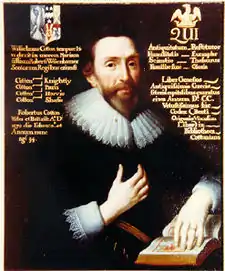
Speed naturally drew extensively on the work of his predecessors, including Christopher Saxton and John Norden as cartographers, William Camden as chorographer (Britannia 1586),[62] and upon Stow and other late chroniclers, in so vast an undertaking (for which Speed considered his own powers quite insufficient), while at the same time revising, improving, verifying and subjecting to scholarly scrutiny all that he could, and where possible obtaining new expert contributions. Some letters survive from Speed to Sir Robert Cotton, written in the years before publication, asking for assistance in gathering necessary materials.[63] Speed acknowledged gratefully that Sir Robert's cabinets were unlocked and his library set open, to supply the "chiefest garnishments" of this work, such as antique altars and trophies, and ancient coins, seals and medals: that the books and collections of John Barkham were similarly brought to his assistance; and that William Smith, Rouge Dragon, had particularly helped in matters of heraldry.[34]
From the first page of the Histories a fresh approach is afoot. Speed dispenses with the full list of pseudo-historic rulers stemming from Brutus the supposed founder of Britain, drawn from Geoffrey of Monmouth's History of the Kings of Britain and repeated by Stow,[64] and instead touches upon the Trojan theory in his discussion of the Name of Britain. Coming into the Saxon narrative, marginal references identify the sources of information from Gildas (De Excidio Britanniae), Bede, Widukind of Corvey and many others, presenting an erudite voice and a discursive historical method, while preserving the structure and chronology relating to the seven kingdoms, and illustrating coins and other materials in true antiquarian fashion. James Spedding, noting the limitations in Speed's account of Henry VII, allowed that his Historie "was enriched with some valuable records and digested with a more discriminating judgement than had been brought to the task before."[65]
History of Great Britaine
In the first edition of his History of Great Britaine (1611),[66] following the "Proem", the historical text begins as page 155 of the whole work, to which the maps of that edition are counted as occupying the preceding page-numbers, and presented separately as The Theatre of the Empire of Great Britain.[67] "This collection makes a noble apparatus to his history", observed Richard Gough, who noted that these were the first maps in which all the counties are divided into hundreds, and that those which Speed derived from Saxton's maps were mostly so corrected or amended as to supersede any attribution to Saxton. The County descriptions printed on the reverse of the maps were mainly adapted from those of William Camden.[68] Speed's magnum opus is from this point a twin Chorographical and Historical work. In the issue of 1614 and the second, revised and augmented edition (of 1623)[69] the whole work is introduced as being in ten Chapters, of which the first four (the "Chorographicall Part") are the maps, arranged as:
- (1) Describing the whole Kingdome in generall, with those Shires, Cities, and Shire-townes which are properly accounted for English
- (2) Containing the Counties of Wales (13)
- (3) Scotlands Kingdom in one Generall (1)
- (4) Containing the Kingdome of Ireland – a general plan, and maps of Munster, Leinster, Connaught and Ulster (5)
The work then proceeds to the "Historicall Part", Books 5-10, arranged as follows:
- (5) The Site, Names, Ancient Inhabitants, Manners, Government, Governors, Costume and Appearance of Great Britain and the Ancient British.
- (6) The Monarchs of Great Britain under the Romans (54 sections).
- (7) The Saxon Kings and English Monarchs, from the downfall of Britain and the origins and arrival of the Saxons, through the Heptarchy, from Hengest (sect. 13) to Edmund Ironside (sect. 45).
- (8) The Danish rulers, with their origins and first assaults, and in detail from Cnut to Harold II (7 sections).
- (9) The Norman rulers and their origins, continued from William I to the end of Elizabeth I (24 sections).
- (10) "James, our dread Soueraigne".
The many coins, seals and other antiquities illustrated in Speed's text were cut by the Swiss wood-engraver Christoph Schweitzer. An important feature of the History is Speed's "Catalogue of the Religious Houses, Colledges, and Hospitals Sometimes in England and Wales", appended to the reign of Henry VIII,[70] said to have been compiled by the elder William Burton.[71][72][34] The list was published in Latin in 1622 as "Catalogus ex Anglico Ioannis Speed, Latinus", as appendix to Nicholas Harpsfield's Historia Anglicana Ecclesiastica.[73]
The Theatre of the Empire of Great Britaine

Speed is now best-known as a map-maker, and above all for his atlas, The Theatre of the Empire of Great Britaine (1611, 1616, 1623), which attempted a complete set of individual county maps of England and Wales, as well as maps of Ireland and a general map of Scotland.[74][75] A 21-year royal privilege (franchise) for the printing of Speed's Theatre was granted to George Humble in April 1608.[76] The collection developed cumulatively, together with his History, and was undertaken with the encouragement of William Camden.[9][77] The entire work, including the History, was dedicated to King James I as the ruler in whom the distinct Kingdoms of the British Isles had been brought together under one rule in such a way as to form an Empire.[78][51]
In the Introduction to his "well affected and favourable reader", Speed acknowledged that he had "copied, adapted and compiled the work of others" rather than making an entirely new survey. He took various existing maps as his models, crediting five to Christopher Saxton, five to John Horden, two to William Smith, one to Philip Symonson (Kent) and others to John Harrington (Rutland), William White, Thomas Durham, James Burrell, and Geradus Mercator. Much of the engraving was done in Amsterdam at the workshop of the Flemish engraver Jodocus Hondius, to whom Speed's project was recommended by Camden,[79] and with whom Speed collaborated from 1606 until Hondius's sudden death in 1612.[80] The maps were printed by William Hall and John Beale, and sold by John Sudbury and George Humble.[81][82]

Speed is admired also for his detailed plans of principal British towns, several of which are the earliest-known depictions of those places and provide valuable topographical insights.[80] Most, but not all, of the county maps have town plans inset; those showing a Scale of Passes (i.e., Paces, reckoned at five feet imperial) were surveyed by Speed himself. On the back of the maps a text in English appears, describing the areas shown: a rare 1616 edition of the British maps has the text in Latin, in a translation by Philemon Holland, thought to have been produced for the Continental market.[83] His maps of English and Welsh counties were often bordered with costumed figures ranging from nobility to country folk.[84] Speed drew historical maps as well as those depicting present times, showing (for instance) invasions of England and Ireland, or the Anglo-Saxon Heptarchy,[85][86][87] a subject previously attempted (probably by Laurence Nowell) for William Lambarde's Archaionomia published in 1568.[88]
The "Gardner copies" in the Cambridge University Library are a collection of proof impressions from the engraved copper plates, taken during the process of checking the detail before the publication of 1611.[16][77] In describing his intentions Speed admitted the possibility of errors despite his best endeavours:
my purpose... in this Island (besides other things) is to shew the situation of every Citie and Shire-town only... The Shires divisions into Lathes, Hundreds, Wapentakes and Cantreds, according to their ratable and accustomed manner, I have separated, and under the same title that the record beareth, in their due places distinguished: wherein by help of the tables annexed, any Citie, Towne, Borough, Hamlet, or Place of Note may readily be found, and whereby safely may be affirmed, that there is not any one Kingdome in the World so exactly described, as is this our Island of Great Britaine... In shewing these things, I have chiefly sought to give satisfaction to all, without offence to any...[89]
The maps, in two-folio spreads, represented: Fol. 1, The British Isles; 3, England (General); 5, The Saxon Heptarchy; 7, Kent; 9, Sussex; 11, Surrey; 13, Hampshire; 15, Isle of Wight; 17, Dorset; 19, Devon; 21 [73], Cornwall; 23, Somerset; 25, Wiltshire; 27, Berkshire; 29, Middlesex; 31, Essex; 33, Suffolk; 35, Norfolk; 37, Cambridgeshire; 39, Hertfordshire; 41, Bedfordshire; 43, Buckinghamshire; 45, Oxfordshire; 47, Gloucestershire; 49, Herefordshire; 51, Worcestershire; 53, Warwickshire; 55, Northamptonshire; 57, Huntingdon; 59, Rutland; 61, Leicestershire; 63, Lincolnshire; 65, Nottinghamshire; [67], Derbyshire; 69, Staffordshire; 71, Shropshire; 73 [21], Cheshire; 75, Lancashire; 77, Yorkshire; 79, West Riding; 81, North and East Ridings; 83, Durham-Bishopric; 85, Westmorland; 87, Cumberland; 89, Northumberland; [91], Isle of Man; 93, Islands (Holy Island, the Farne Islands, the Channel Islands). 99, Wales (General); 101, Pembrokeshire; 103, Carmarthenshire; 105, Glamorganshire; 109, Radnorshire; 111, Cardiganshire; 113, Montgomeryshire; 115, Merionethshire; 117, Denbighshire; 119, Flintshire; 121, Carnarvonshire; 123, Anglesey. 131, Scotland (General). 137, Ireland (General); 139, Munster; 141, Leinster; 143, Connaught; 145, Ulster. In 2016, the British Library reprinted this collection of maps of the British Isles with an introduction by Nigel Nicolson and commentaries by Alasdair Hawkyard.[5][90]
Counties (examples)
 The Countie Pallatine of Lancaster described and divided into hundreds, 1610
The Countie Pallatine of Lancaster described and divided into hundreds, 1610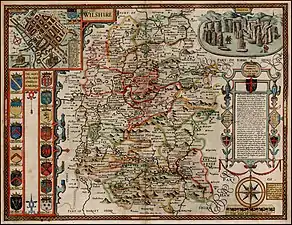 Wilshire, 1610, with a town plan of Salisbury and a view of Stonehenge
Wilshire, 1610, with a town plan of Salisbury and a view of Stonehenge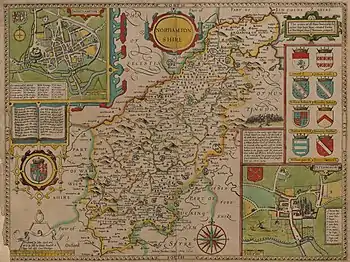 Northamptonshire, 1610
Northamptonshire, 1610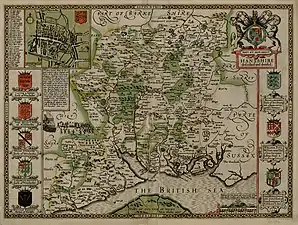 Hampshire, 1610
Hampshire, 1610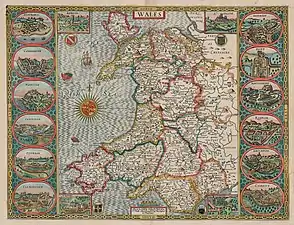 Wales, 1610
Wales, 1610
Town inserts (examples)
Views of Welsh towns (examples)
Speed represented Wales as a separate province from England but not as an independent entity.[91][92]
 Bangor, 1610
Bangor, 1610 Brecon, 1610
Brecon, 1610 Cardiff, 1610
Cardiff, 1610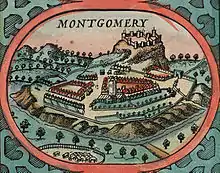 Montgomery, 1610
Montgomery, 1610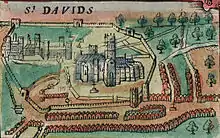 St David's, 1610
St David's, 1610
A Prospect of the Most Famous Parts of the World
In 1627, two years before his death, was published Speed's A Prospect of the Most Famous Parts of the World, printed by John Dawson for George Humble.[93][94] This was the first world atlas produced by an Englishman.[95] The principal sheets included the continents of 3, Asia, 5, Affrica, 7, Europe, 9, America;[96] with the following domains, 11, Greece; 13, The Romane Empire; 15, Germanie; 17, Bohemia; 19, France; 21, Belgia; 23, Spaine; 25, Italia; 27, Hungarie; 29, Denmarke; 31, Poland; 33, Persia; 35, Turkish Empire; 37, Kingdom of China; 39, Tartarie; 41, Sommer Islands (Bermudas).[97] With it were also included the County and Kingdom maps from the Theatre, corresponding to the third edition of that work, together with a New and Accurat Map of the World in a double hemisphere projection.[98] A facsimile edition was published in 1966.[99]
At 40 shillings, its circulation was limited to wealthier sort of customers, and to libraries, where many copies are nowadays preserved.[80][100][96][101][102][103][104]
.jpg.webp) A Newe Mape of Germany, 1626
A Newe Mape of Germany, 1626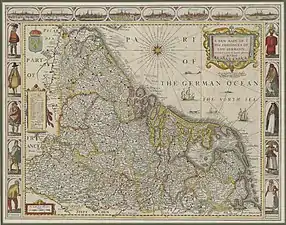 A New Mape of Ye XVII Provinces, 1626 (The Netherlands)
A New Mape of Ye XVII Provinces, 1626 (The Netherlands) The Kingdome of China, 1626
The Kingdome of China, 1626 Italia, 1626
Italia, 1626
Family
The pedigree for "Speed of Southampton", as prepared by the antiquary Benjamin Wyatt Greenfield in 1896, has the marriage of John Speed and Susanna daughter of Thomas Draper, Esq., of London, at its head, and shows the descendants of their son John. Although stating that Speed was born in 1542, and giving other dates which conflict with variant sources, it presents the names of six children. They are shown as:[17]
- John Speed (1595-1640), M.D. (1628), studied at Merchant Taylor's School (1603-04), and was Scholar (1612), B.A. (1616), M.A. (1620) and Fellow of St John's College, Oxford. He married Margaret, daughter of Bartholomew Warner, M.D., of St John's College (Professor of Physic). John died testate in 1640[105] and is buried in the chapel of St John's College.[106][26] Their sons:
- John Speed was a student of St John's College, Oxford in 1652, and was Mayor of Southampton in 1681 and 1694.[26][106]
- Samuel Speed, D.D. of Christ Church, Oxford, died in 1674.[106]
- Samuel Speed, Merchant Taylor of London,[26] who married Joan, daughter of Richard Joyner, alias Lloyd, of Abingdon, and had a son Samuel who died in 1633
- Nathan Speed
- Joan Speed, who married John Hayley, Esq., of London
- Sarah Speed, who married Edward Blackmore, Esq., of London
- Anne Speed, who married Benjamin Wesley, citizen and Merchant Taylor of London
His arms, granted by William Camden, are: "Gules, on a chief or, two swifts volant proper". Crest: "On a wreath or and gules a swift volant proper."[17] His monument, in the escutcheon within the broken pediment above the niche, shows these arms impaling "Azure a chevron Ermine between three estoiles Or."
From their funeral monument, it appears that John and Susanna Speed had 12 sons and 6 daughters in all. Speed's descendants included Sir Keith Speed, MP (1934–2018).[107]
Monument and epitaph
Wall monument
Richard Newcourt described the monument to John Speede at St Giles without Cripplegate. "...the famous Chronologer and Historiographer John Speed, lies buried here, and hath a Monument on the South-side of the Chancel, with this inscription on one side for him, and on the other for his Wife":
.jpg.webp)
Piæ Memoriæ Charissimorum Parentum -
Johannis Speed, Civis Londinensis Mercatorum Scissorum Fratris, servi fidelissimi Religiarum Majestatum, Eliz., Jacobi & Caroli nunc superstitis: Terrarum nostrarum Geographi accurati, & fidi Antiquitatis Britannicæ Historiographi, Genealogii sacræ elegantissimi delineatoris, qui postquam Annos 77. superaverat, non tam Morbo confectus, quam Mortalitatis taedio lassatus, Corpore se levavit, Julii 28. 1629. & jucundissimo Redemptoris sui desiderio sursum elatus carnem hic in custodiam posuit, denuo cum Christus venerit recepturus.[39]
(To the Pious Memory of Most Beloved Parents"[108] – [that is to say,]
of John Speed, Citizen of London of the Brethren of Merchant Taylors, a very faithful servant of their Devout Majesties Elizabeth, James and Charles that now is: the accurate Geographer of our Lands, reliable Historiographer of the Antiquity of Britain, and most elegant delineator of the sacred Genealogies, who, after he had lived 77 years, not so much defeated by illness as wearied out by the burden of Mortality, arose from the Body on 28 July 1629, and, being borne aloft in the joyous desire of his Redeemer, he laid down his flesh here in keeping, to be received anew when Christ shall come.)
Susannae suae suavissimae, quae postquam duodecim illi filios, & sex filias pepererat quinquaginta septem annos junctis utriusque solatiis, cum illo vixerat; liberos gravi et frequenti hortamine, ad Dei cultum solicitaverat; Pietatis et Charitatis opere quotidiano praeluxerat, emori demum erudiit suo exemplo. Quae septuagenaria placide in Christo obdormivit, et Fidei suae mercedem habuit, Martii vigesimo octavo, Anno Domini MDCXXVIII.[109][110]
(Also of his sweetest Susannah, who after she had borne him twelve sons and six daughters, lived jointly in companionship with him for fifty seven years; she encouraged her children in their duty to God by serious and frequent exhortation; she shone brightly in the daily work of piety and charity, and at last gave instruction by her example of how to surrender life. Who as a septuagenarian placidly fell asleep in Christ and received the reward of her faith on 28 March, in the Year of Our Lord 1628.)
Although the monument was damaged by enemy action in 1940–1941, an engraving of 1791 by John Thomas Smith shows how the panels carrying the inscriptions were originally disposed as if forming the opened hinged doors of a cabinet.[111] The church's website notes that it was "one of the few memorials that survived the bombing" of this church during the London Blitz of 1940–1941:[40] a modern plaque records that the monument was restored in 1971 by the Merchant Taylors' Company, in which John Speed was a citizen and brother.
Monumental brass
In 1944 Sir William Burrell and Constance, Lady Burrell included a monumental brass, stated to be for the cartographer John Speed, among their collection donated to the city of Glasgow. It is described as a tomb brass representing a full-length male figure, 62.7 cm tall, facing three-quarters to the right [i.e. his left side turned away], his hands joined in prayer. He has short hair with a trimmed beard and moustache, and wears a gown and cape over a buttoned tunic surmounted by a ruff.[112] The expression "tomb brass" suggests that this figure may have belonged to a group set into the covering slab of a stone table tomb (as opposed to a floor matrix), an inference supported by the comparatively unworn condition of the engraving.
The latten is torn away at the toe, suggesting a forceful detachment, but the rivet-holes by which the brass was originally attached to its stone matrix are neatly preserved, suggesting careful removal. The position of the figure indicates that there was once a corresponding, facing plate representing a wife. The squared edge of the brass plate below the foot possibly rested against another brass plate bearing an inscription. The descriptions by Newcourt, Strype and Granger of Speed's monument agree with the text (including the words "On the other side of him" to introduce the inscription for Susanna) given in Anthony Munday's 1633 edition of Stow's Survey of London,[113] and all clearly refer to the wall monument and inscriptions depicted by Smith and now remaining in restored form. If, however, the attribution of this brass to a tomb monument for John Speed is correct, it may enlarge the view of the original appearance of Speed's monument as it stood on the south side of the chancel of St Giles. The brass is on display in the Burrell Collection.
Interpretations
John Speed and William Shakespeare
William Shakespeare had near connections with St Giles, Cripplegate parish, of which John Speed was a parishioner. In his account of the reign of King Henry V, John Speed mentions that the character of Sir John Oldcastle, a Lollard martyr in Henry V's time, was falsely represented in the theatres as a stock buffoon and rogue. He wrote,
The author of The Three Conversions hath made Oldcastle a ruffian, a robber and a rebel, and his authority, taken from the stage players, is more befitting the pen of his slanderous report, than the credit of the judicious, being only grounded from this papist and his poet, of like conscience for lies, the one ever feigning and the other ever falsifying the truth.[114]
The author of The Three Conversions was the Jesuit Robert Persons, and the references to the Lollard martyr Oldcastle are in the third part of the work.[115] Speed is saying that Persons the Catholic author had infamously falsified the historical character of Oldcastle the Lollard martyr by representing him as the cowardly rebel portrayed in the late Elizabethan stage plays. Thomas Fuller, in his Church-History of Britain (1655), evidently echoes Speed where he remarks:
Stage-poets have themselves been very bold with, and others very merry at, the memory of Sr John Oldcastle, whom they have fancied a boon Companion, a jovial Royster, and yet a Coward to boot, contrary to the credit of all Chronicles, owning him a Martial man of merit. The best is, Sr John Falstaffe, hath relieved the Memory of Sr John Oldcastle, and of late is substituted Buffoone in his place, but it matters as little what petulant Poets, as what malicious Papists, have written against him."[116]
While Shakespeare's character of Sir John Falstaff is evidently based on the stage-Oldcastle model, under a different name, the inference drawn by some editors (since Nicholas Rowe) that Speed was referring specifically to Shakespeare,[117] or (if he was), that he intended to associate Shakespeare directly with Robert Persons and his Catholic sympathies,[118][119] has long been debated:[120][121][122][123] possibly, Speed was referring to the author of a different play in which the Oldcastle figure appeared by name. A summary of the argument was presented by Edmond Malone's editors.[124]
John Speed's maps and associated commentaries are sometimes employed for the interpretation of William Shakespeare's plays.[125][126] Speed's historiography employs "theatrical metaphors" and makes use of medieval mythical content.[127]
Persistence
His maps being used in many circles, Speed's influence was long-lasting and far-reaching. In 1673 and 1676 (long after his death), other maps were published under his name,[128] representing the British Isles, the Chesapeake Bay region, specifically Virginia and Maryland,[129] the East Indies, the Russian Empire (then ruled by Peter the Great),[130] Jamaica, and Barbados (and other locations).[131][132][133][134][135][136][137] With these printings and many others, Speed's maps became the basis for world maps until at least the mid-eighteenth century: his British maps formed an important topographical resource long after their original publication.[30]
 A New And Accvrat Map of the World, 1646 miniature edition
A New And Accvrat Map of the World, 1646 miniature edition.png.webp) Jamaica, 1676
Jamaica, 1676
Appreciation
In later years, Robert Sheringham (who recited Speed's text to his map of the Isle of Wight) referred to him as "summus et eruditus Antiquarius" (a foremost and erudite antiquary),[138] and he was called "our English Mercator";[139] "a person of extraordinary industry and attainments in the study of antiquities" (by William Nicolson);[140][141] an "honest and impartial historian... who was furnished with the best materials from some of the most considerable persons in this kingdom" (by Stephen Hyde Cassan),[142] a "faithful Chronologer" (in a text of 1656),[143] and "our Cheshire historian...a scholar...a distinguished writer on history" (by Charles Hulbert).[144] Richard Newcourt called him a "celebrated chronologer and historiographer";[145] James Granger observed, "his History of Great Britain was in its kind incomparably more complete than all the histories of his predecessors put together."[146]
"And thus" (says Thomas Fuller), "we take our leaves of Father Speed, truly answering his name, in both the acceptions thereof, for celerity and success."[7]
Published works
- The Theatre of The Empire of Great Britaine, Presenting an exact geography of England, Scotland, and Ireland (London 1611–12). Full text (including the History) at Umich/eebo.
- Theatrum Imperii Magnae Britanniae, Latin Edition (London 1616). Page views at gallica (Bibliothèque Nationale Française).
- History of Great Britaine Under the Conquests of Romans, Saxons, Danes, and Normans, 1st Edition (London 1611), text at Umich/eebo. Re-issue (London 1614), page views at Google. Second, Revised Edition (London 1623), page views at Google.
- The Genealogies recorded in the Sacred Scriptures according to euery family and tribe with the line of Our Sauior Jesus Christ obserued from Adam to the Blessed Virgin Mary (London 1611). 1636 printing bound into 1637 Robert Barker bible, page views at Google.
- A Cloud of Witnesses: and they the holy genealogies of the sacred scriptures. Confirming unto us the truth of the histories in Gods most holie word; and the humanitie of Christ Iesus 1st Edition (London 1616). Second Edition (London 1620), text at Umich/eebo.
- England, Wales, Scotland and Ireland: Described and Abridged with Ye Historic Relation of Things Worthy Memory: from a Farr Larger Voulume (London 1627) The "Farr Larger Volume" is The Theatre of The Empire of Great Britaine.
- A Prospect of the Most Famous Parts of the World (London 1627)
References
- Bendall, Sarah (2008) [2004]. "Speed, John (1551/2–1629), historian and cartographer". Oxford Dictionary of National Biography (online ed.). Oxford University Press. doi:10.1093/ref:odnb/26093. (Subscription or UK public library membership required.); superseding Pollard, Albert (1898). . Dictionary of National Biography. Vol. 53. pp. 318–320. .
- "Life of John Speed", The Hibernian Magazine, Or, Compendium of Entertaining Knowledge, July 1782, p. 348 (Google).
- Hewitt, Rachel (2010). Map of a Nation. London: Granta Publications. pp. xxvi. ISBN 978-1-84708-254-1.
- A. Baynton-Williams, 'John Speed': Relocated since 17 Sept 2012 at Mapforum.com as "Biography: John Speed", Jan 2022 (www. mapforum.com).
- John Speed, eds N. Nicolson and A. Hawkyard, The Counties of Britain: A Tudor Atlas, Thames & Hudson (1989) ISBN 0-500-25104-5: Pavilion Books (1992) ISBN 1-85145-131-5; (pbk, 1995) ISBN 1-85793-612-4.
- A full coloured original set of Speed's British maps, with their descriptive texts in the Latin 1616 edition of the Theatre, can be viewed online at gallica (Bibliothèque Nationale Française).
- 'John Speed', in T. Fuller, The History of the Worthies of England (J.G., W.L. and W.G., London 1662), p. 184 (Internet Archive).
- Date calculated from Memorial Inscription formerly in St Giles, Cripplegate.
- Pollard, Albert (1898). . Dictionary of National Biography. Vol. 53. pp. 318–320.
- Palmer, A.N. (1907). "The Town of Holt, in County Denbigh". Archaeologia Cambrensis. 6th ser. 7: 389–434 (425).
- C. M. Clode, The Early History of the Guild of Merchant Taylors of the Fraternity of St John the Baptist, London, 2 vols (Harrison and Sons, London 1888), II: The Lives, p. 332 (Internet Archive).
- J.L. Chester, ed. J. Foster, London Marriage Licences 1521-1869 (Bernard Quaritch, London 1887), Col. 1265 (Internet Archive).
- "Life of John Speed", in W. West, The history, topography and directory of Warwickshire (R. Wrightson, Birmingham 1830), pp. 36–37 (Google).
- 'The loving brother of the Mystery, John Speed', in Clode, Early History of the Merchant Taylors, II, at pp. 332-35 (Internet Archive).
- 1572 in Greenfield's pedigree of Speed: variant sources give 1575. Susanna died in 1628 after 57 years of marriage to John, according to her M.I.
- A. Taylor, "A Theatre of Treasures", Cambridge University Library Special Collections, 11 October 2016.
- B.W. Greenfield, 'Pedigree of Speed of Southampton', in J.J. Howard (ed.), Miscellanea Genealogica Et Heraldica Series 3, vol. 2.i, March 1896 (London: Mitchell and Hughes, 1898), pp. 18–25 (Internet Archive).
- E. Kell, 'On the Castle and Other Ancient Remains at Southampton', Journal of the British Archaeological Association, Ser.1, XXI (1865), pp. 285-93, at pp. 289–290, note 2 (Internet Archive).
- R. Gough, Anecdotes of British Topography: Or, an Historical Account of What Has Been Done For Illustrating The Topographical Antiquities of Great Britain and Ireland (London: W. Richardson and S. Clark, 1768, reprinted in 2014), pp. 184, 448.
- Palmer, "The Town of Holt", pp. 421, 425, 429.
- W. Goffart, Historical Atlases: The First Three Hundred Years, 1570–1870 (Chicago: University of Chicago Press, 2003), p. 54.
- 'Speed's description of Warwickshire, section (6)', in W. West, The History, Topography and Directory of Warwickshire, pp. 41-45, at p. 43 (Internet Archive).
- J. Taylor, "John Speed's 'Canaan' and British Travel to Palestine", in D. G. Burke, J. F. Kutsko and P. H. Towner (eds), The King James Version at 400: Assessing Its Genius as Bible Translation and Its Literary Influence (Atlanta: Society of Biblical Literature, 2013), pp. 103ff., at pp. vi, 102, 104–119, 121, 159, 182.
- M. A. E. Green (ed.), Calendar of State Papers, Domestic, Elizabeth, 1598–1601, vol. 267: June 1598 (Longmans, Green & Co., London 1869), p. 62 (Internet Archive). "Room" and "place" here mean "vacant post", not "empty chamber", since Speed is to "discharge the same".
- W. Goffart, "The First Venture into 'Medieval Cartography'", in J. A. Roberts, J. L. Nelson and M. Godden (eds), Alfred the Wise: Studies in Honour of Janet Bately on the Occasion of her Sixty-Fifth Birthday (Woodbridge, UK: D.S. Brewer, 1997), at pp. 57–58.
- Clode, Early History of the Guild of Merchant Taylors, II, pp. 332-33 (Internet Archive).
- T. Speght (ed.), The Workes of our Ancient and Learned English Poet, Geffrey Chaucer, newly printed (Adam Islip for George Bishop, London 1598, 1602), frontis. (Internet Archive).
- "Quosinter clarissimum virum Johannem Speedaeum, principe loco, Historiae Britannicae studioso commendare nullus dubitem", etc, in D. Wheare, Relectiones Hyemales, de Ratione et Methodo Legendi Utrasque Historias, etc., at pp. 114-15 (Google) of the John George Cotta edition (Tubingen 1700) of the 1637 Latin original.
- D. Wheare, The Method and Order of Reading both Civill and Ecclesiasticall Histories (M. Flesher for Charles Brome, London 1685), Part 1, Section XXXI, pp. 164-168; full text at Umich/eebo.
- The Maps of John Speed Archived 12 April 2016 at the Wayback Machine, Shakespeare's England, 10 August 2010.
- T.J. Werth, The Fabulous Dark Cloister: Romance in England after the Reformation (Baltimore: Johns Hopkins University Press, 2011), 49.
- K. Macfarlane, 'The Biblical Genealogies of the King James Bible (1611): Their Purpose, Sources, and Significance', The Library, vol. 19, issue 2, (June 2018), pp. 131–158 (academic.oup). See also '3. From Chronology to Genealogy', in K. Macfarlane, Biblical Scholarship in an Age of Controversy: The Polemical World of Hugh Broughton (1549-1612) (Oxford University Press 2021), pp. 85-111 (Google).
- C.M. Clode, The Early History of the Guild of Merchant Taylors of the Fraternity of St John the Baptist, London, 2 vols (Harrison and Sons, London 1888), I, p. 333 (Internet Archive).
- A. Kippis, 'John Speed', in Biographia Britannica, 6 vols (J. Walthoe, etc., London 1763 edition), vol. 6 pt 1, pp. 3773–775, at p. 3774, note E (Google).
- Speed, History, 1st edition (1611), p. 897 (Google).
- Speed, History, 1st edition (1611), Front matter (Google).
- R. Leech, "Documentary evidence - Temple Fee and the Rack Closes", in K. Colls, 'The Avon Floodplain at Bristol: Excavations at Templar House, Temple Way, in Bristol 2004 and 2005', Transactions of the Bristol and Gloucestershire Archaeological Society CXXVIII (2010), pp. 73-120 (Society's pdf), at p. 106 (pdf p. 35).
- J. Bruce (ed.), Calendar of State Papers, Domestic, Charles I: 1625-1626 (Longman, Brown, Green, Longman, & Roberts, London 1858), p. 308, no. 72 (Google).
- R. Newcourt, Repertorium Ecclesiasticum Parochiale Londinense (Bateman, Tooke, Parker, Bowyer and Clements, London 1708), I, p. 356 (Google).
- "Heritage". St Giles' without Cripplegate. Retrieved 17 September 2012.
- Hibbert, Christopher; Ben Weinreb; John Keay; Julia Keay (2010). The London Encyclopaedia. London: Pan Macmillan. p. 762. ISBN 978-0-230-73878-2.
- H. Broughton, A Concent of Scripture (Richard Watkins for Gabriell Simson and William White, London 1588/1589), full text at Umich/eebo.
- J. Lightfoot (ed.), The Works of the Great Albionean Divine: Renown'd in Many Nations for Rare Skill in Salems & Athens Tongues (London: Nathaniel Ekins, 1662), Preface (Google): cited by Macfarlane.
- H. Broughton and J. Speed, A direction to finde all those names expressed in that large table of genealogies of Scripture lately gathered by I.S. whereof the first number serueth for the side margentes, and the later answerable to the highest fygures (London, ?1595), full text at Umich/eebo.
- M.A.E. Green (ed.), Calendar of State Papers, Domestic, James I: 1603-1610 (Longman, Brown, Green, Longmans, & Roberts, London 1857), p. 639 (Google).
- See, e.g., a 1636 printing bound in with a 1637 Robert Barker bible in the British Library, digitized at Google.
- J. Speed, A Clowd of Witnesses and They the Holy Genealogies of the Sacred Scriptures (By John Beale for Daniel Speed, in Pauls Church Yard at the sign of the Blazing Starre, 1616): page views at Google.
- J. Speed, A Clowd of Witnesses and They the Holy Genealogies of the Sacred Scriptures. Confirming unto us the truth of the histories in Gods most holy word, and the humanitie of Christ Iesus. The second addition. (John Beale, London 1620): full text at Umich/eebo.
- (Worldcat).
- J. Speed, History of Great Britaine Under the Conquests of Romans, Saxons, Danes, and Normans, 2nd, revised edition (London 1623), Dedication page (Google).
- N. Canny, 'The Origins of Empire: An Introduction', in N. Canny (ed.), The Origins of Empire: British Overseas Enterprise to the Close of the Seventeenth Century, The Oxford History of the British Empire series, vol. 1 (New York: Oxford University Press, 2005, reprint), at pp. 1-2 (Google). It was Speed who used the phrase "the Empire of Great Britaine", which differed from Thomas Blennerhasset's expression, "great Brittaines imperial crowne".
- e.g. J. Stow, A Summarie of the Chronicles of England. Diligently collected, abridged, and continued unto... 1598 (Richard Bradocke, London 1598), page views at Google.
- J. Stow, The Chronicles of England from Brute Unto this Present Yeare of Christ 1580 (R. Newberie and H. Bynneman, London 1580), full text at Umich/eebo.
- J. Stow, The Annales of England 2nd edition (Felix Kyngston for Ralphe Newbery, London 1601), page views at Internet Archive.
- D.R. Woolf, Reading History in Early Modern England (Cambridge University Press, 2000), at pp. 39-42 (Google).
- C.L. Kingsford, English Historical Literature in the Fifteenth Century (Clarendon Press, Oxford 1913), p. 268 (Hathi Trust).
- G.J.R. Parry, 'John Stow's unpublished "Historie of this Iland": amity and enmity amongst sixteenth-century scholars', English Historical Review, CII (1987), pp. 633–47.
- W. Howard of Naworth (ed.), Florentii Wigorniensis monachi Chronicon ex Chronicis ab initio mundi usque ad Ann. Dom. 1118 (Excudebat Thomas Dausonus pro Ricardo Watkins, London 1592), page views at Google.
- As "Matthaeus Westmonasteriensis" (Thomas Marsh, London 1573), page views at Google; (with Florentius Wigorniensis) (Typis Wechelianis apud Claudium Marnium et heredes Ioannis Aubrii, Frankfurt 1601), page views at Google.
- H. Savile, Rerum Anglicarum Scriptores post Bedam (G. Bishop, R. Nuberie and R. Barker, London 1596). Page views at Internet Archive.
- Opera Bedae Venerabilis Presbyteri, Anglosaxonis: Viri in Diuinis atque Humanis Literis Exercitatissimi: omnia in octo tomos distincta (Basileae: Joannes Hervagius 1563), p. 1 ff. (Google).
- W. Camden, Britannia, sive Florentissimorum Regnorum, Angliae, Scotiae, Hiberniae et Insularum adiacentium ex intima antiquitate Chorographica descriptio (Cum Privilegio: Ralph Newbery, London 1587), pageviews at Google.
- 'XXXI: John Speed the Historian to Sir Robert Cotton' (etc.), in H. Ellis (ed.), Original Letters of Eminent Literary Men (Camden Society, London 1843), p. 104, and pp. 108–113 (Google).
- J. Stow, "The race of the Kings of Brytaine after the received opinion since Brute, &c", in The Annales of England (Felix Kyngston for Ralphe Newbery, London 1601), at pp. 11-21 (Internet Archive).
- J. Spedding, 'Preface to the History of the Reign of Henry VII', in J. Spedding, R.L. Ellis and D.D. Heath (eds), The Works of Francis Bacon, Baron of Verulam, vol. 6: Literary and Professional Works, vol. 1, New Edition (Longmans & Co., London 1870), at p. 4 (Internet Archive).
- J. Speed, The History of Great Britaine under the conquests of the Romans, Saxons, Danes and Normans. Their Originals, Manners, Warres, Coines, and Seales: with ye Successions, Lives, Acts, & Issues of the English Monarchs from Julius Caesar, to our most gracious soueraigne King Iames, 1st Edition (Imprinted by William Hall and Iohn Beale for John Sudbury and George Humble, cum Privilegio, London 1611), text at Umich/eebo; (1614 reissue), page views at Google.
- J. Speed, C. Schweitzer, J. Hondius, The Theatre of the Empire of Great Britaine: Presenting an Exact Geography of the Kingdomes of England, Scotland, Ireland, and the Iles Adioyning: with the Shires, Hundreds, Cities and Shire-townes, within ye kingdome of England, divided and described by Iohn Speed (William Hall for Iohn Sudbury & Georg Humble, London 1611/1612); full text (with county descriptions, etc), at Umich/eebo.
- R. Gough, Anecdotes of British Topography: Or, an Historical Account of What has been Done for Illustrating the Topographical Antiquities of Great Britain and Ireland (T. Payne and W. Brown, London 1768), p. 42 (Google).
- J. Speed, History of Great Britaine Under the Conquests of Romans, Saxons, Danes, and Normans, Second, Revised Edition (London 1623); page views at Google.
- Speed, History of Great Britain (1611/1614), pp. 787-802 (Google); (1623), pp. 1059–1105 (Google).
- "In Catalogo Monasteriorum (a Gulielmo Burton (ut accepi) collecto, et apud Spedum edito)...": H. Spelman, Concilia, Decreta, Leges, Constitutiones in Re Ecclesiarum Orbis Britannici, 3 vols (R. Badger, for Ph. Stepani and Ch. Meredith, London 1636), I, p. 215, Note (Google).
- W. Nicolson, "J. Speed", in The English Historical Library (Abell Swall and T. Child, London 1696), I, pp. 194-95 (Google).
- "Catalogus Religiosarum Ædium ex Anglico Ioannis Speed, Latinus", in N. Harpsfield and E. Campion, ed. R. Gibbon, Historia Anglicana Ecclesiastica (Marcus Wyon, Douai 1622), pp. 741-79 (Google).
- J. Speed, ed. N. Nicolson and A. Hawkyard, Britain's Tudor Maps: County by County (Batsford 2017), pp. 9–10, 13, 15–16. Nicolson's introduction is at pp. 7-15.
- James Granger, in the '"Corrections and Additions Supplement" of his Biographical History of England, vol. 3 (T. Davies, etc., London 1774), p. 234 (Google), referring to vol. 1, p. 503, corrects his former, erroneous statement that Speed's County Maps "were the first set ever published in England", substituting that they were "very justly esteemed".
- M. A. E. Green (ed.), Calendar of State Papers, Domestic, James I: 1603-1610 (Longman, Brown, Green, Longmans, & Roberts, London 1857), p. 425 (Google).
- Theatre of the Empire, Gardner Collection, digitized images of the collection (Classmark: Atlas 2.61.1) at Cambridge University Library.
- C. Ivic, "Mapping British identities: Speed's 'Theatre of the Empire of Great Britaine'," in D. J. Baker and W. Maley (eds), British Identities and English Renaissance Literature, (Cambridge, UK: Cambridge University Press, 2002), at pp. ix, 135, 138, 141, 150, 162, 248.
- "LXIII. G. Camdenus Jodoco Hondio", in T. Smith (ed.), V. Cl. Gulielmi Camdeni et Illustrium Virorum ad G. Camdenum Epistolae (Richard Chiswell, London 1691), pp. 87-88 (Google).
- N. Nicolson, "Introduction", in John Speed, ed. Nicolson and Hawkyard, Britain's Tudor Maps: County by County (London: British Library, reprint, 2016, originally published in 1988), pp. 7–15.
- Andrew, "Speed maps now in the Cambridge Digital Library", Cambridge University Library Special Collections, 23 March 2015.
- Gough, Anecdotes of British Topography, p. 42 (Google).
- Theatrum Imperii Magnæ Britanniæ: exactam regnorum Angliæ Scotiæ Hiberniæ et insularum adiacentium geographia[m] ob oculos ponens: una cum comitatibus, centurijs, urbibus et primarijs comitatum oppidis intra regnum Angliæ, divisis et descriptis. Opus, nuper quidem à Iohanne Spédo cive Londinensi Anglicè conscriptum: nunc verò, à Philemone Hollando, apud Coventrianos medicinæ doctore, Latinitate donatum (T. Snodham apud Ioann Sudbury et Geo. Humble, London 1616). Page views at gallica (Bibliothèque Nationale Française).
- A. McRae, God Speed the Plough: The Representation of Agrarian England, 1500–1660 (Cambridge, UK: Cambridge University Press, 2002, reprint), pp. xi, 231–232, 238.
- Goffart, Historical Atlases, pp. xi, 38, 54, 80–81, 83, 105, 112, 123, 201, 203, 443, 471.
- Gough, Anecdotes of British Topography, pp. 595, 608.
- Speed, ed. Nicolson and Hawkyard, Britain's Tudor Maps (2017), pp. 18–21.
- W. Lambarde, Archaionomia, sive De Priscis Anglorum Legibus Libri (John Day, London 1568). View Lambarde's Map as re-used by Day in the Acts and Monuments, at dhi.ac.uk.
- "Speed's Address to His Readers", in West, The History, Topography and Directory of Warwickshire, at pp. 38–41 (Internet Archive).
- Speed, ed. Nicolson and Hawkyard, Britain's Tudor Maps (2017), pp. 6–152.
- C. Ivic, "'bastard Normans, Norman bastards': anomalous identities in 'The Life of Henry the Fift'", in P. Schwyzer and W. Maley (eds), Shakespeare and Wales: From the Marches to the Assembly (Burlington, VT: Ashgate Publishing Company, 2010), pp. 75–82.
- R. Hingley, The Recovery of Roman Britain 1586–1906: A Colony So Fertile (New York: Oxford University Press, 2008), pp. 17, 21, 23, 36, 40, 44–53.
- J. Speed, A Prospect of the Most Famous Parts of the World: Together with that Large Theater of Great Brittaines Empire (John Dauson for George Humble, London 1627).
- Library of Congress catalog,A prospect of the most famovs parts of the vvorld, London, Printed by John Dawson for G. Humble, 1627.
- See Mapforum articles, Issue 03 (Relocated 2022), "John Speed: A Prospect of the Most Famous Parts of the World" (mapforum.com).
- "America with those known parts in that unknowne worlde both people and manner of buildings, 1626". View 3 copies at the Library of Congress digital resource (www.loc.gov).
- See Image of title page of 1631 edition at The Layton Collection, London (thomaslayton.org.uk). Select "Zoom in".
- View at Yale University Library digital collections (digital.library.yale.edu). See also a coloured example at the Norman B. Leventhal Map Center, Boston Public Library, in Wikimedia.
- R.A. Skelton (ed.), John Speed. A Prospect of the Most Famous Parts of the World. London 1627 (facsimile), Theatrum Orbis Terrarum, 3rd Series, volume VI (Amsterdam 1966).
- M. Wynne-Davies, Sidney to Milton, 1580–1660 (New York: Palgrave Macmillan, 2003), pp. 138–141, 171, 179–180, 197.
- Library of Congress catalog, The ilands, London. Are to be solde in Popes Heade Alley by Iohn Sudb. and G. Humbell, 1610.
- Library of Congress catalog, newe mape of Poland, 1611.
- F.J. Bremer, John Winthrop: America's Forgotten Founding Father (New York: Oxford University Press, 2013), 206.
- Thomas Suarez, Early Mapping of Southeast Asia: The Epic Story of Seafarers, Adventurers, and Cartographers Who First Mapped the Regions Between China and India (London: Tuttle Publishing, 2012), p. 512.
- Will of Doctor John Speede, Doctor of Physic, Doctor in Medicine of University of Oxford (PCC 1640, Coventry quire).
- "Speede, John", in J. Foster (ed.), Alumni Oxonienses 1500–1714 (Oxford, 1891), pp. 1394–1422 (British History Online).
- "Sir Keith Speed, former Navy minister – obituary". The Daily Telegraph. 22 January 2018 – via www.telegraph.co.uk.
- Although "grandparents" might be included in the Latin term "parentes", the meaning here is probably "parents" as this inscription was apparently already in existence in 1633, within 4 years of Speed's death.
- J. Strype (ed.), A Survey of the Cities of London and Westminster (1720), Book 3, Chapter 6, pp. 85-86 (HRI/University of Sheffield).
- See also G. Ormerod, The History of the County Palatine of Chester, 3 vols (Lackington, Hughes, Harding, Mavor, and Jones, London 1819), II, p. 406 (Internet Archive).
- See also J. J. Baddeley, An Account of the Church and Parish of St Giles, without Cripplegate, in London (Author, London 1888), pp. 90-92 (Internet Archive).
- "Tomb brass: John Speed (born 1542 [sic], died 1629)", Burrell Collection: European Bronzes and Brasswares (except Statuary), ID 5-6.142. View image and description in Glasgow Museums collections navigator (retrieved 12 July 2022).
- 'The Remaines', in A. Munday (ed.), The Survey of London; contayning the Orignall, Increase, Moderne Estate and Government of that Citie, begun by Iohn Stow (Elizabeth Purslow for Nicholas Bourne, London 1633), at pp. 776-77 (Internet Archive).
- J. Speed, The History of Great Britain Under the Conquests of the Romans, etc., 2nd edition (1623), p. 804 (Google).
- (Robert Persons), The Third Part of A Treatise Intituled: of Three Conversions of England, conteyninge. an examen of the Calendar or Catalogue of Protestant Saints... [etc]. By N. D. (Imprinted with licence, Anno Dni 1604), pp. 196-99 and pp. 244-55 (Google).
- T. Fuller, The Church-history of Britain from the Birth of Jesus Christ until the Year M.DC.XLVIII (Iohn Williams, London 1655), Book IV, Section II, Chapter 40, p. 168 (Umich/eebo).
- P. Corbin and D. Sedge (eds), The Oldcastle Controversy: "Sir John Oldcastle, Part 1" and "The Famous Victories of Henry V", The Revels Plays Companion Library (Manchester University Press, 1991).
- H.J. Heller, Penitent Brothellers: Grace, Sexuality, and Genre in Thomas Middleton's City Comedies (Newark: University of Delaware Press, 2000), p. 181 (Google).
- J. Waterfield, The Heart of His Mystery: Shakespeare and the Catholic Faith in England Under Elizabeth and James (New York: iUniverse, 2009), pp. 4, 643.
- J.-C. Mayer, "'This Papist and his Poet': Shakespeare's Lancastrian kings and Robert Parsons's Conference about the next Succession", in R. Dutton, A. G. Findlay and R. Wilson (eds), Theatre and Religion: Lancastrian Shakespeare (Oxford, UK: Manchester University Press, 2003), pp. 116-29, at pp. 116, 127, 128, 236.
- V.B. Richmond, Shakespeare, Catholicism, and Romance (New York: Bloomsbury Publishing, 2015), 13.
- G. Holderness, The Faith of William Shakespeare (UK: British Library, 2016), 47.
- H. Bloom, William Shakespeare's Romeo and Juliet (New York: Infobase Publishing, 2009), 75.
- E. Malone (ed.), The Plays and Poems of William Shakspeare: with the Corrections and Illustrations of Various Commentators (F.C. and J. Rivington, etc., London 1820), XVI, Note to Henry IV Part 1, at p. 193 and note 3, and pp. 410-19, note (Google).
- C.A. Matza Jr. (ed.), Boudica: Historical Commentaries, Poetry, and Plays (USA: XLibris, 2010), pp. 83–90.
- M. Cordner, P. Holland, and J. Kerrigan (eds), English Comedy (Cambridge, UK: Cambridge University Press, 2006 reprint), pp. 85, 98.
- I. Djordjevic, King John (Mis)Remembered: The Dunmow Chronicle, the Lord Admiral's Men, and the Formation of Cultural Memory (New York: Routledge, 2016), pp. 43, 61, 86, 117, 122.
- See Mapforum Articles, Relocated 2022: Issue 4, "John Speed: Subsequent Ownership of Speed's Plates" (mapforum.com).
- 1676 John Speed and F. Lamb Map of Virginia and Maryland (Chesapeake Bay), Geographicus Rare Antique Maps, 2017. (Commercial website)
- C.E. Puckett, ""A Map of Russia", c.1676 – John Speed", 1676. (Commercial website)
- R. Gough, British Topography (T. Payne and Son, and J. Nichols, London 1780), I, pp. 91-92 (Internet Archive).
- Antique Maps Online, John Speed Maps – Antique 17th Century, 2017. (Commercial website)
- "Published in John Speed's 'Theatre of the Empire of Great Britaine' between 1611 & 1676 and Henry Overton's 'England Described' from c.1713 to c.1756",Welland Antique Maps & Prints (2014). (Commercial website)
- Mapseeker, John Speed County Maps Archived 6 April 2017 at the Wayback Machine, 2014. (Commercial website)
- Ebth, "John Speed Original 1676 Map "The Province of Mounster"", 2013–2017. (Commercial website)
- Baumann Rare Books, "Map of Huntington both Shire and Shire Towne", 2017. (Commercial website)
- An Epitome of Mr. John Speed's Theatre of the Empire of Great Britain (London, Printed for T. Basset, and R. Chiswell, 1676), Library of Congress catalog, .
- R. Sheringham, De Anglorum Gentis Origine Disceptatio (Edward Story, Cambridge 1670), pp. 42-43 (Google).
- T. Park, "Edward, Lord Montague", A Catalogue of the Royal and Noble Authors of England, Scotland, and Ireland, vol. 3 (London: John Scott, 1806), pp. 265-66.
- W. Nicolson, The English Historical Library (Abel Swall and T. Child, London 1696), p. 13 (Google).
- A new and general biographical dictionary, vol. 10 (London: Printed for multiple individuals, 1762), pp. 454–455.
- S. H. Cassan, The Lives of the Bishops of Winchester from Birinus, vol. 1 (London, C. and J. Rivington, 1827), p. 513 (Google).
- T.B. Howell, A Complete Collection of State Trials and Proceedings for High Treason and Other Misdemeanors, vol. 5 (London: T. C. Hansard, 1816), 827.
- C. Hulbert, "The Memoir of John Speed", Cheshire Antiquities, Roman, Baronial and Monastic (C. Hulbert, Shrewsbury and Providence Grove/H. Washbourne, London 1838), pp. 62–65.
- J. Entick, A new and accurate history and survey of London, Westminster, Southwark, and Places Adjacent (London: Edward and Charles Dilly, 1766), 139.
- J. Granger, A Biographical History of England from Egbert the Great to the Revolution, 3rd Edition, with additions and improvements (J. Rivington and Sons, etc., London 1779), vol. 2, p. 320 (Google).
External links
- Zoomable digital reproduction of a 1611/12 proof of Speed's atlas The Theatre of the Empire of Great Britaine, held by Cambridge University Library.
- John Speed Online maps from Occidental College, Los Angeles.
- Information about John Speed and his maps Archived 22 April 2019 at the Wayback Machine from Antique Maps.
- John Speed and John Ogilby, 15-16th century cartographers, a guide to Speed and John Ogilby, with a focus on their cartographic works available at Stanford University.

.jpg.webp)
